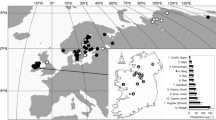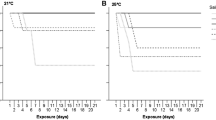Abstract
In estuaries, the somatic growth of crustacean mysids may be influenced by spatio-temporal variation in salinity and food resources. We tested such a possibility in a laboratory experiment, where somatic growth of sub-adult mysids Tenagomysis chiltoni and Tenagomysis novaezealandiae was studied in intermediate salinities(10–20) with contrasting high or low (based on Carbon and Nitrogen richness) food qualities. Different salinity and/or food quality combinations interacted to produce contrasting growth trajectories between the two species. Growth of sub-adult T. chiltoni was more influenced by salinity, whereas the growth of T. novaezealandiae more strongly affected by food quality. Our results suggest that small environmental changes to salinity and food regimes may give rise to different growth trajectories among sub-adult mysids which may have a cascading influence on their life histories and patterns of coexistence with other species in small intermittently open/closed estuaries in temperate regions.


Similar content being viewed by others
References
Amarasinghe PB, Boersma M, Vijverberg J (1997) The effect of temperature, and food quantity and quality on the growth and development rates in laboratory-cultured copepods and cladocerans from a Sri Lankan reservoir. Hydrobiologia 350:131–144. doi:10.1023/A:1003087815861
Astthorsson OS, Ralph R (1984) Growth and moulting of Neomysis integer (Crustacea: Mysidacea). Mar Biol 79:55–61. doi:10.1007/BF00404985
Atkinson D (1995) Effects of temperature on the size of aquatic ectotherms: exceptions to the general rule. J Therm Biol 20:61–74. doi:10.1016/0306-4565(94)00028-H
Bierschenk AM, Savage C, Townsend CR, Matthaei CD (2012) Intensity of land use in the catchment influences ecosystem functioning along a freshwater-marine continuum. Ecosystems 15:637–651. doi:10.1007/s10021-012-9536-0
Carrasco NK, Perissinotto R (2011) Temperature and salinity tolerance of Mesopodopsis africana O. Tattersall in the freshwater-deprived St Lucia Estuary, South Africa. J Exp Mar Biol Ecol 399:93–100. doi:10.1016/j.jembe.2011.01.014
Charmantier G (1996) Ontogeny of osmoregulation in crustaceans: a review. Invertebr Reprod Dev 33:177–190. doi:10.1080/07924259.1998.9652630
Conover DO (1992) Seasonality and the scheduling of life history at different latitudes. J Fish Biol 41:161–178. doi:10.1111/j.1095-8649.1992.tb03876.x
Delgado L, Guerao G, Ribera C (2011) Effects of different salinities on juvenile growth of Gammarus aequicauda (Malacostraca: Amphipoda). I J Zool, Article ID 248790. doi:10.1155/2011/248790
DeLisle PF, Roberts MH (1987) Osmoregulation in the estuarine mysid, Mysidopsis bahia Molenock: comparison with other mysid species. Comp Biochem Physiol A Physiol 88:369–372. doi:10.1016/0300-9629(87)90499-3
Fenton GE (1996a) Production and biomass of Tenagomysis tasmaniae Fenton, Anisomysis mixta australis(Zimmer) and Paramesopodopsis rufa Fenton from south-eastern Tasmania (Crustacea: Mysidacea). Hydrobiologia 323:23–30. doi:10.1007/BF00020544
Fenton GE (1996b) Diet and predators of Tenagomysis tasmaniae Fenton, Anisomysis mixta australis (Zimmer) and Paramesopodopsis rufa Fenton from south-eastern Tasmania (Crustacea: Mysidacea). Hydrobiologia 323:31–44. doi:10.1007/BF00020545
Fockedey N, Mees J, Vangheluwe M, Verslycke T, Janssen CR, Vincx M (2005) Temperature and salinity effects on post-marsupial growth of Neomysis integer (Crustacea: Mysidacea). J Exp Mar Biol Ecol 326:27–47. doi:10.1016/j.jembe.2005.05.005
Fockedey N, Ghekiere A, Bruwiere S, Janssen CR, Vincx M (2006) Effect of salinity and temperature on the intra-marsupial development of the brackish water mysid Neomysis integer (Crustacea: Mysidacea). Mar Biol 148:1339–1356. doi:10.1007/s00227-005-0160-9
Gotthard K (2001) Growth strategies of ectothermic animals in temperate environments. In: Atkinson D, Thorndyke M (eds) Environment and animal development. BIOS Scientific Publishers, Oxford, pp 287–304
Hanselmann AJ, Gergs R, Rothhaupt KO (2011) Embryonic development time of the freshwater mysid Limnomysisbenedeni Czerniavskyas a function of water temperature. Aquat Ecol 45:539–546. doi:10.1007/s10452-011-9374-8
Jocque M, Blom W (2009) Mysidae (Mysida) of New Zealand; a checklist, identification key to species and an overview of material in New Zealand collections. Zootaxa 2304:1–20
Jones MB, Greenwood JG, Greenwood J (1989) Distribution, body size, and brood characteristics of four species of mysids (Crustacea: Peracardia) in the avon heathcote estuary, New Zealand. NZ J Mar Freshw Res 23:195–199. doi:10.1080/00288330.1989.9516356
Lehtiniemi M, Viitasalo M, Kuosa H (2002) Diet composition influences the growth of the pelagic mysid shrimp, Mysis mixta (Mysidacea). Boreal Environ Res 7:121–128
Lill AWT, Lal A, Closs GP (2010) Life history and reproduction of two abundant mysids (Mysidacea: Mysidae) in an intermittently open New Zealand estuary. Mar Freshw Res 61:633–641. doi:10.1071/MF09085
Lill AWT, Closs GP, Savage C, Schallenberg M (2011) Annual secondary production of two estuarine mysid species (Mysidacea: Mysidae) inhabiting an intermittently closed estuary, south-eastern New Zealand. Mar Freshw Res 62:823–834. doi:10.1071/MF10274
McKenney CL, Celestial DM (1995) Interactions among salinity, temperature, and growth of the estuarine mysid Mysidopsis bahia reared in the laboratory in the complete life cycle. I: body mass and age specific growth rate. J Crust Biol 15:169–178. doi:10.1163/193724095X00668
Miranda-Filho KC, Pinho GLL, WasieleskyJr W, Bianchini A (2009) Long-term ammonia toxicity to the pink-shrimp Farfantepenaeus paulensis. Comp Biochem Physiol C Toxicol Pharmacol 150:377–382. doi:10.1016/j.cbpc.2009.06.001
Nielson SK (1984) Scaling: why is animal size so important? Cambridge University Press, Cambridge and New York, pp 1–256
Paul S, Krokosek M, Probert PK, Closs GP (2013) Osmoregulation and survival of two mysids of Tenagomysis from southern estuaries of New Zealand. Mar Freshw Res 64:340–347. doi:10.1071/MF12316
Preston T, Owens NJ (1983) Interfacing an automatic elemental analyzer with an isotope ratio mass spectrometer: the potential for fully automated total nitrogen and nitrogen-15 analysis. Analyst 108:971–977. doi:10.1039/AN9830800971
R Development Core Team (2013) ‘R: a language and environment for statistical computing. R Foundation for Statistical Computing: Auckland. www.r-project.org. Accessed November 2013
Roast SD, Thompson RS, Widdows J, Jones MB (1998) Mysids and environmental monitoring: a case for their use in estuaries. Mar Freshw Res 49:827–832. doi:10.1071/MF97099
Rudstam LG, Hetherington AL, Mohammadian AM (1999) Effect of temperature on feeding and survival of Mysis relicta. J Great Lakes Res 25:363–371. doi:10.1016/S0380-1330(99)70745-8
Sterner RW, Robinson JL (1994) Thresholds for growth in Daphnia magna with high and low phosphorus diet. Limnol Oceanogr 39:1128–1132
Sutherland DL, Closs GP (2001) Diel patterns of mysid drift (Crustacea: Mysidacea) in the Taieri River Estuary, New Zealand. NZ J Mar Freshw Res 35:197–200. doi:10.1080/00288330.2001.9516990
Urbina M, Paschke K, Gebauer P, Chaparro OR (2010) Physiological energetics of the estuarine crab Hemigrapsuscrenulatus (Crustacea:Decapoda:Varunidae): responses to different salinity levels. JMBA U.K. 90:267–273. doi:10.1017/S0025315409990889
Viherluoto M, Kuosa H, Flinkman J, Viitasalo M (2000) Food utilization of pelagic mysids, Mysis mixta and M. relicta during their growing season in northern Baltic Sea. Mar Biol 136:553–559. doi:10.1007/s002270050715
Wilhelm FM, Hamann J, Burns CW (2002) Mysid predation on amphipods and Daphnia in a shallow coastal lake: prey selection and effects of macrophytes. Can J Fish Aquat Sci 59:1901–1907. doi:10.1139/f02-161
Winkler G, Greve W (2002) Laboratory studies of the effect of temperature on growth, moulting and reproduction in the co-occurring mysids Neomysis integer and Praunus flexuosus. Mar Ecol Prog Ser 235:177–188. doi:10.3354/meps235177
Xue S, Fang J, Zhang J, Jiang J, Mao Y, Zhao F (2013) Effects of temperature and salinity on the development of the amphipod crustacean Eogammarus sinensis. Chin J Oceanol Limnol 31:1010–1017. doi:10.1007/s00343-013-2302-0
Yamada H, Kawamura T, Takeuchi T, Yamashita Y (1995) Effects of dietary condition on the survival, growth and reproduction of Acanthomysis mitsukurii (Crustacea, Mysidacea). Bull Plankt Soc Jpn 42:43–52
Acknowledgments
We thank Nicky McHugh for assistance with the analysis of water samples, Ken Miller for art work, and the IRMS laboratory at Department of Chemistry, University of Otago for isotopic analysis of food samples. Thanks to Dr. Keith Probert (University of Otago), Dr. Knudsen Rune (University of Tromsø) for their comments on the manuscript, and Jolyn Chia and Makenzie Gallium for their assistance in field and laboratory work. Thanks to Department of Zoology, and University of Otago for infrastructure and funding support.
Author information
Authors and Affiliations
Corresponding author
Additional information
Handling Editor: Piet Spaak
Rights and permissions
About this article
Cite this article
Paul, S., Closs, G.P. Effects of salinity and food quality on the growth of sub-adult mysids of Tenagomysis spp.: a laboratory study. Aquat Ecol 48, 229–235 (2014). https://doi.org/10.1007/s10452-014-9478-z
Received:
Accepted:
Published:
Issue Date:
DOI: https://doi.org/10.1007/s10452-014-9478-z




